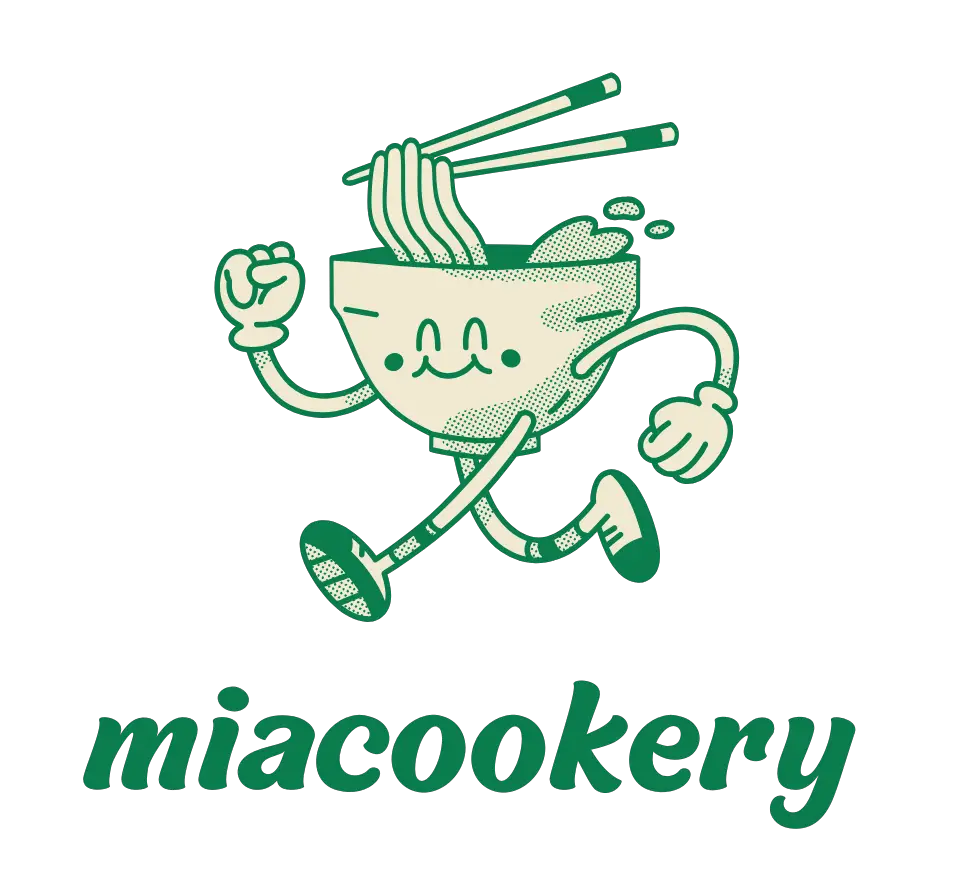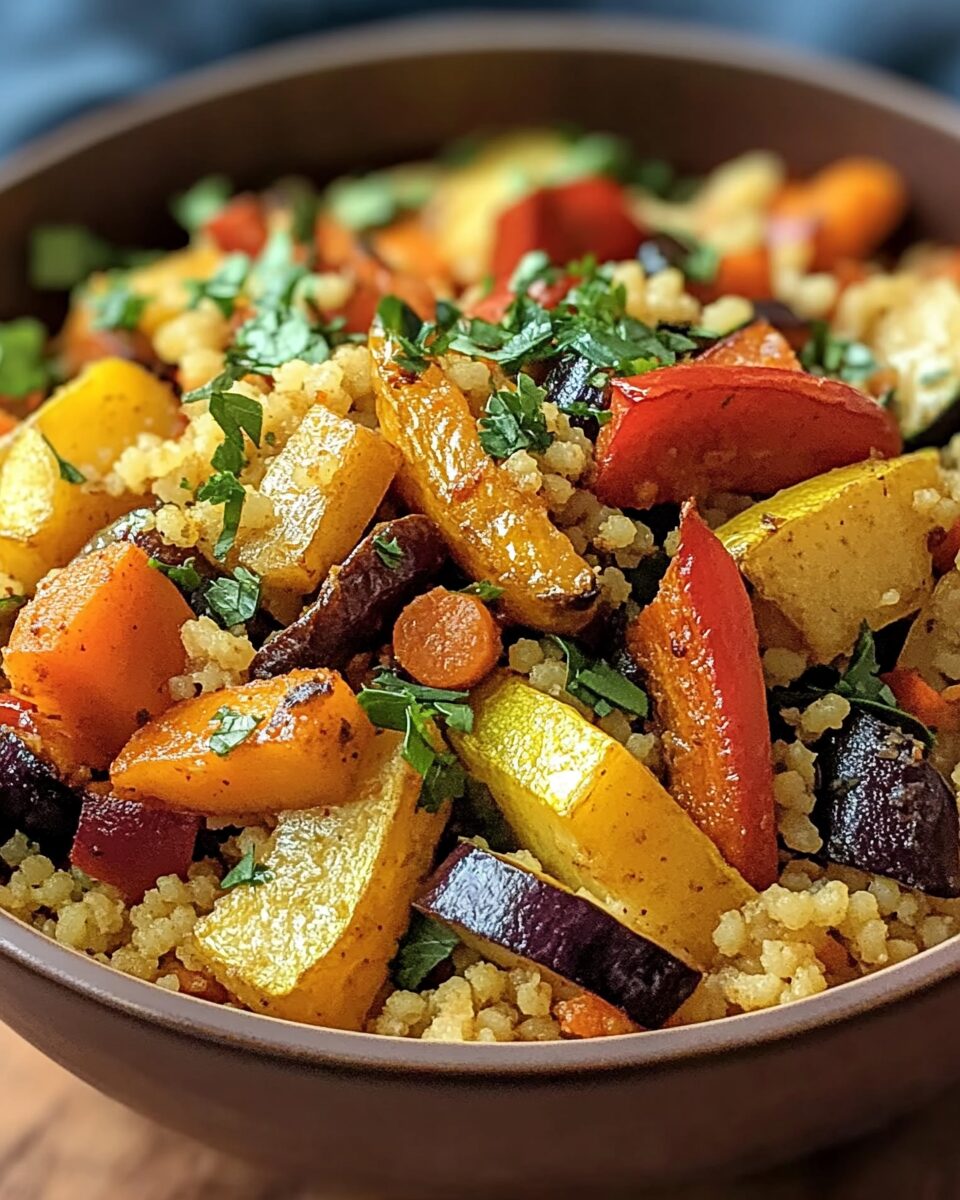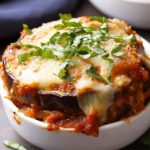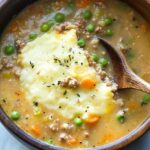This Moroccan Couscous with Roast Vegetables is a vibrant, nutrient-packed dish that brings the exotic flavors of North Africa to your kitchen. Featuring a medley of roasted bell peppers, zucchini, red onion, and carrots, combined with perfectly cooked couscous and aromatic spices, this dish is both satisfying and wholesome. The addition of fresh herbs and optional toppings like chickpeas, toasted almonds, and dried fruit elevates the flavors, making each bite an explosion of textures and tastes. Whether served as a hearty vegetarian main course or a flavorful side dish, this recipe is versatile, easy to prepare, and ideal for meal prepping. The warm, earthy spices blend harmoniously with the natural sweetness of the roasted vegetables, while a squeeze of lemon adds the perfect finishing touch. Enjoy a taste of Morocco in every spoonful!
Full Recipe:
Ingredients:
For the Roasted Vegetables:
- 1 red bell pepper, chopped
- 1 yellow bell pepper, chopped
- 1 zucchini, sliced
- 1 red onion, sliced
- 1 cup cherry tomatoes, halved
- 2 carrots, sliced
- 2 tbsp olive oil
- 1 tsp ground cumin
- 1 tsp smoked paprika
- ½ tsp ground coriander
- ½ tsp turmeric
- Salt and pepper to taste
For the Couscous:
- 1 cup couscous (whole wheat for extra fiber, if preferred)
- 1 cup water or vegetable broth
- ¼ tsp salt
- 1 tbsp olive oil
Optional Add-Ins and Garnishes:
- ½ cup canned chickpeas, drained and rinsed
- ¼ cup toasted almonds, chopped
- ¼ cup dried apricots or raisins, chopped
- Fresh parsley or cilantro, chopped
- Lemon wedges for serving
Directions:
- Prepare the Vegetables for Roasting
- Preheat your oven to 400°F (200°C).
- Place the chopped bell peppers, zucchini, red onion, cherry tomatoes, and carrots on a large baking sheet.
- Drizzle with olive oil, then sprinkle with cumin, paprika, coriander, turmeric, salt, and pepper.
- Toss the vegetables until evenly coated, spreading them out in a single layer.
- Roast in the preheated oven for 25-30 minutes, or until the vegetables are tender and slightly caramelized, stirring halfway through.
- Cook the Couscous
- In a medium pot, bring 1 cup of water or vegetable broth to a boil with 1/4 tsp salt.
- Remove the pot from heat, add the couscous, and cover with a lid. Let it sit for 5 minutes to absorb the liquid.
- Fluff the couscous with a fork, drizzle with 1 tbsp olive oil, and set aside.
- Assemble the Moroccan Couscous with Roasted Vegetables
- In a large mixing bowl, combine the couscous with the roasted vegetables.
- If using, add chickpeas, toasted almonds, and dried fruit for extra texture and flavor.
- Toss gently to combine, adjusting seasoning with salt and pepper as needed.
- Garnish and Serve
- Garnish with fresh parsley or cilantro and serve with lemon wedges on the side for a bright finishing touch.
- Serve warm as a main dish or a side, accompanied by other Moroccan-inspired dishes if desired.
Prep Time: 15 minutes | Cooking Time: 35 minutes | Total Time: 50 minutes
Kcal: 350 kcal | Servings: 4 servings
The Cultural Significance of Couscous in Moroccan Cuisine
Couscous has been a fundamental part of North African cuisine for centuries, dating back to the Berber tribes of the Maghreb region (which includes Morocco, Algeria, Tunisia, and Libya). Traditionally, couscous was hand-rolled from semolina wheat and steamed in a couscoussier, a special pot that allows it to absorb steam while maintaining its light, fluffy texture.
In Morocco, couscous is often regarded as a dish of hospitality, bringing families and communities together. It is commonly served on Fridays, the Islamic holy day, as a celebratory meal after communal prayers. Moroccan couscous dishes can vary widely, from rich meat-based versions with lamb or chicken to entirely plant-based renditions like this roasted vegetable couscous.
Beyond its role in family gatherings, couscous is a dish deeply rooted in Moroccan festivals and special occasions. It symbolizes abundance and generosity, often prepared in large quantities to be shared among friends and guests. The addition of roasted vegetables makes this variation particularly appealing to vegetarians and those looking for a nutritious yet flavorful meal.
Health Benefits of Moroccan Couscous with Roast Vegetables
This dish is not only packed with bold flavors but also brimming with essential nutrients that contribute to a well-balanced diet. Here’s a closer look at its health benefits:
1. High in Fiber and Complex Carbohydrates
Whole wheat couscous, which can be used in this recipe, is an excellent source of fiber, which aids digestion, promotes gut health, and helps maintain steady blood sugar levels. The complex carbohydrates in couscous provide a steady release of energy, making it a satisfying meal that keeps you full for longer.
2. Rich in Antioxidants and Vitamins
The roasted vegetables in this dish such as bell peppers, zucchini, carrots, and cherry tomatoes are loaded with vitamins A and C, which support the immune system and promote healthy skin. The inclusion of red onions adds quercetin, a powerful antioxidant known for its anti-inflammatory properties.
3. Packed with Plant-Based Protein
While couscous itself contains some protein, adding chickpeas to the dish enhances its protein content, making it a great option for vegetarians and vegans. Chickpeas are rich in essential amino acids, iron, and folate, all of which contribute to overall well-being.
4. Boosts Heart Health
The olive oil used to roast the vegetables and season the couscous is a source of healthy monounsaturated fats, which help lower bad cholesterol levels and support heart health. Additionally, spices like turmeric and cumin offer anti-inflammatory benefits that further promote cardiovascular well-being.
5. Supports Weight Management
This dish is relatively low in calories while still being satisfying. The combination of fiber, protein, and healthy fats ensures that you feel full and energized without unnecessary calorie overload, making it a great addition to a weight-conscious diet.
Variations and Customization
One of the best things about Moroccan couscous with roasted vegetables is its versatility. You can easily customize the dish based on seasonal produce, dietary preferences, or personal taste. Here are a few ways to make it your own:
1. Add a Sweet Element
For a more traditional Moroccan touch, consider incorporating dried fruits such as raisins, dried apricots, or chopped dates. Their natural sweetness balances the savory and spiced flavors of the dish beautifully.
2. Include More Protein
While chickpeas are a fantastic plant-based protein option, you can also add grilled tofu, tempeh, or even spiced lentils for a protein boost. If you’re not following a vegetarian diet, grilled chicken or shrimp can be excellent additions.
3. Experiment with Different Vegetables
Although bell peppers, zucchini, and carrots are commonly used, you can swap them out for other roasted vegetables like eggplant, sweet potatoes, or butternut squash for a unique flavor profile.
4. Add a Crunchy Element
Toasted almonds, pine nuts, or pumpkin seeds add an enjoyable crunch and an extra dose of healthy fats. These toppings also enhance the dish’s visual appeal.
5. Make It Gluten-Free
If you’re avoiding gluten, you can substitute couscous with gluten-free grains like quinoa, millet, or even cauliflower rice for a lower-carb alternative.
Serving Suggestions
Moroccan couscous with roasted vegetables is a flexible dish that can be enjoyed in multiple ways. Here are some serving ideas:
- As a Main Course: Serve it warm as a satisfying vegetarian meal, garnished with fresh herbs and a squeeze of lemon juice. A side of hummus or a dollop of yogurt adds creaminess and complements the dish beautifully.
- As a Side Dish: Pair it with Moroccan tagines, grilled meats, or falafel for a balanced and flavor-packed meal.
- Cold as a Salad: This dish tastes fantastic as a chilled salad. Simply prepare it in advance, refrigerate it, and enjoy a refreshing meal the next day.
- With a Spicy Kick: Drizzle some harissa or sprinkle in a bit of cayenne pepper for those who enjoy a bit of heat in their meals.
Tips for Storage and Reheating
If you have leftovers, this dish stores well and is easy to reheat while maintaining its delicious flavors. Here’s how to store and reheat it properly:
1. Storing in the Refrigerator
- Place the couscous in an airtight container and store it in the fridge for up to 4 days.
- Keep any garnishes (such as fresh herbs or nuts) separate to maintain their texture.
2. Freezing for Longer Storage
- Moroccan couscous with roasted vegetables can be frozen for up to 3 months.
- Store it in individual portions for easy meal prep.
- Thaw it overnight in the refrigerator before reheating.
3. Reheating Without Drying It Out
- Stovetop Method: Add a splash of water or vegetable broth to the couscous and heat it in a pan over low-medium heat, stirring occasionally until warmed through.
- Microwave Method: Place the couscous in a microwave-safe dish, add a little water, cover with a damp paper towel, and heat in 30-second intervals until warm.
Conclusion:
Moroccan Couscous with Roast Vegetables is a delightful, nutritious, and versatile dish that brings the flavors of Morocco to your table. Its combination of aromatic spices, fluffy couscous, and caramelized vegetables makes it a satisfying meal for any occasion. Whether you’re looking for a quick weeknight dinner, a meal prep-friendly dish, or an impressive side for a gathering, this recipe offers the perfect balance of convenience, flavor, and nourishment.
By experimenting with different ingredients and serving styles, you can customize this dish to fit your taste preferences and dietary needs. With its rich history, health benefits, and endless variations, Moroccan couscous with roasted vegetables is a dish you’ll want to make again and again.






